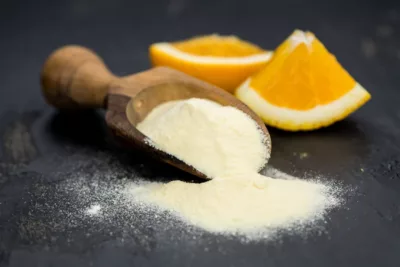Pectin was first scientifically discovered in 1825 by the French chemist, Henri Braconnet. However, people had been making use of pectin for centuries before this. Most of us think of pectin as that ‘magical’ ingredient that makes jam set, but there is much more to it than that! In this short article, we’re going to walk you through some of the basics you need to know to understand and effectively use pectin.
What is Pectin?
Let’s get the bare essentials out of the way first! Fundamentally, pectin is a natural substance found in many fruits and vegetables that helps to provide cohesion and structure to products. However, it’s important to remember that not all forms of pectin are considered ‘natural’ in the food and beverage industry.
Pectin is produced from raw material that has a high natural pectin content – most commonly apples, citrus fruits and sometimes beet. It is part of the plant cell wall, and through a process of extraction, it is separated from the fruit pomace. From here, a filtration process separates the insoluble components, and the filtered extract is concentrated into liquid pectin. Next, the pectin is precipitated and washed and finally pressed, dried and ground into a fine powder.
What is Pectin Used In?
Today pectin is an indispensable component in many food and drink products. As we touched on in the above paragraph, pectin is mainly used for its gelling, thickening and stabilising properties. It’s most famously used in jams but is also used in a variety of other products, including:
- fruit spreads and fruit preparations;
- acidified milk drinks;
- yoghurts (including dairy alternatives);
- desserts;
- confectionery;
- bake-stable fruit fillings;
- sauces and more.

What's the Difference Between Types of Pectins?
As we’ve established, pectin is derived from different sources, which affects how different pectins work.
Citrus pectins: Citrus pectins generally yield an elastic, brittle texture. Pectin derived from citrus is also lighter in colour and provides a more clear gel than apple pectins.
Apple pectins: These pectins result in a more elastic-viscous texture. As opposed to citrus pectins, apple pectins will provide a smoother and softer gel, better for spreading.
As well as coming from different sources, pectins are also classified into different grades.
HM & LM Pectins
- You can have high methyl ester (HM) and low methyl ester (LM) pectins. Pectins are considered HM when the degree of esterification exceeds 50% and they are considered LM when this is less than 50%.
- HM pectins form gels with high soluble solids (sugar) and low pH, so these are ideal for jams.
- LM pectins form gels with calcium. This makes them suitable for applications with lower sugar, such as fruit preparations.
Amidated Pectins
- Amidated pectins have part of the pectin replaced with amide groups. The amidated part of the pectin allows additional hydrogen bonds to be formed, meaning that gels can be created with less calcium required.
- Amidated pectins can be used in a variety of applications including fruit fillings.
You can achieve very different textures and functionality in the end product depending on which grade and which source pectin you are working with.
Pros and Cons of Using Pectin
Pectin is a fantastic ingredient that has wide-ranging functionality that can be useful in a variety of applications. However, it can be a little difficult to work with if you’re not well-versed in its complexities. Like any hot soluble gum, pectin can be tricky to hydrate and activate, which is essential to achieve full functionality. As well as this, HM pectins are sensitive to pH and soluble solids, while LM and amidated pectins are sensitive to calcium. This means that pH, soluble solids and calcium need to be tightly controlled when formulating with pectin. And as with most ingredients, there are longer than usual lead times right now due to supply chain disruptions.
That being said, pectin has a lot to recommend it: a clean taste profile, versatile texture, heat stability, shear stability, protein stabilisation, low dosage and great flavour release compared to other hydrocolloids. But to achieve this functionality, you must ensure that you’re formulating with the correct grade of pectin, using the correct dosage, and are taking acid, solid and mineral levels into account. Pectin also benefits from positive consumer perception. As opposed to other gums, many consumers know what pectin is and it has a clean label image.

How Can We Help?
Pectin is an extremely useful ingredient to have in your ‘toolkit’. However, a sophisticated understanding of its scientific mechanisms is required in order to achieve the best results in your end product.
Here at Hawkins Watts, we have a team of highly experienced application technologists who can advise and work directly with you on your project. We have an excellent range of high-quality pectins available and can help you determine the most suitable product to work with.
If this article has piqued your interest in pectin, or if you have any questions, please feel free to get in touch with Celia or Jono, our resident pectin experts.
Australia
Celia McKeon: celia@hawkinswatts.com.au
New Zealand
Jono Au-Young: jono@hawkinswatts.com
Sources
H&F, The Specialists for Pectin. https://www.herbstreith-fox.de/en/pectins/
Chemistry World podcast, Pectin. https://www.chemistryworld.com/podcasts/pectin/3005903.article




